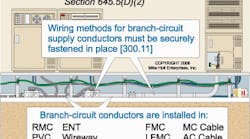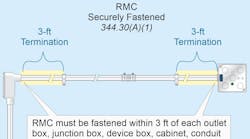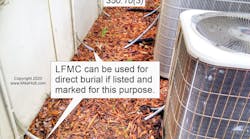Q. Am I required to secure Type MC cable that is located under a raised floor of an information technology equipment room?
A. Yes. All wiring methods under raised floors must be secured in accordance with the wiring method requirements [645.5(D)(2)]. For example, Type MC cable with four or less conductors sized no larger than 10 AWG must be secured within 12 inches of every outlet box, junction box, cabinet, or fitting and at intervals not exceeding 6 feet [330.30].
If the room is compliant with 645.4 and the power cables (MC) are listed as part of, or for, information technology equipment, they are not required to be secured in place per 645.5(E)
Q. How many receptacles can be installed on a generalpurpose branch circuit?
A. The NEC doesn't limit the number of receptacle outlets on a generalpurpose branch circuit in a dwelling unit [220.14(J)], but for other than dwelling units, the NEC limit is 13 receptacle outlets each at 180VA per mounting strap [220.14(I).
Circuit VA = Volts × Amperes
Circuit VA = 120V × 20A = 2,400VA
Number of receptacles = 2,400VA ÷ 180VA = 13
According to the NEC Handbook published by the NFPA, receptacle loads are not considered a continuous load; therefore, the calculation is based on 20A, not 80% of 20A.
Q. How many 12 AWG conductors can I install in a 1inch EMT raceway?
A. EMT must be large enough to permit the installation and removal of conductors without damaging the conductor insulation [358.22]. This is accomplished by complying with conductor fill limitations of Table 1 of Chapter 9. Because all of the conductors are the same size, Annex C, Table C.1 can be used to determine the number of conductors (26 conductors).
Although the NEC permits 26 12 THHN conductors in trade size 1 EMT, 310.15(B)(2)(a) requires the ampacity of the conductors to be adjusted when installing more than three currentcarrying conductors in the raceway.
Q. What are the NEC requirements when using Type MC or NM cable as the feed and switchleg for a singlepole switch?
A. The white conductor within the cable must be used to supply the power to the switch, and it must be permanently reidentified at each location where the conductor is visible to indicate its use as an ungrounded conductor [200.7(C)(2)]. The black conductor is to be used as the switch leg to the luminaire.
Q. What are the rules for terminating more than one conductor on a terminal?
A. The general requirement is that all terminals are rated for the termination of only one conductor. Terminals suitable for more than one conductor must be identified for this purpose, either within the equipment instructions or on the terminal itself [110.14(A)]. Some circuit breakers that are rated 30A or less are listed for the termination of two conductors, and this information is contained in the product instructions.
Q. What are working space requirements for telecommunications equipment?
A. The working space requirement for power equipment contained in 110.26(A) does not apply to communications equipment [90.3]; however, the telecommunications equipment cannot be located in the required workspace for power equipment.
Q. Can a receptacle for a LCD projector that is cordandplugconnected be located above a suspended ceiling?
A. No. Cords are not permitted to be run through holes in structural or suspended/dropped ceilings [400.8(2)]. They are also not allowed to be concealed by walls, floors, or ceilings, or located above suspended or dropped ceilings [400.8(5)].
Q. What are the cable fill limitations when installing telecom cable in a raceway?
A. Where communications cables are installed in a Chapter 3 raceway, the raceway must be installed in accordance with Chapter 3. The raceway fill requirements of Chapter 3 and Chapter 9 do not apply [800.110].
Q. Is a disconnect required to be within sight of electric spaceheating equipment if the unit has a factoryinstalled circuit breaker?
A. No. A unit switch with a marked “off” position that is an integral part of the equipment can serve as the heater disconnecting means, if it disconnects all ungrounded conductors of the circuit [424.19(C)].
Q. What are the GFCI protection requirements for 15A and 20A, 125V receptacles?
A. GFCI protection is required for all 15A and 20A, 125V receptacles located in:
(A) Dwelling Units [210.8]:
- Bathroom area
GFCI protection is required for all 15A and 20A, 125V receptacles in the bathroom area of a dwelling unit.
- Garages and accessory buildings
GFCI protection is required for all 15A and 20A, 125V receptacles in garages, and in gradelevel portions of accessory buildings used for storage or work areas of a dwelling unit.
- Outdoors
All 15A and 20A, 125V receptacles located outdoors of dwelling units, including receptacles installed under the eaves of roofs, must be GFCI protected.
Exception to (3): GFCI protection isn't required for a fixed electric snowmelting or deicing equipment receptacle supplied by a dedicated branch circuit, if the receptacle isn't readily accessible and the equipment or receptacle has groundfault protection of equipment (GFPE) [426.28].
- Crawl spaces
All 15A and 20A, 125V receptacles installed in crawl spaces at or below grade of a dwelling unit must be GFCI protected.
- Unfinished basements
GFCI protection is required for all 15A and 20A, 125V receptacles located in the unfinished portion of a basement not intended as a habitable room and limited to storage and work areas.
Exception to (5): A receptacle supplying only a permanently installed fire alarm or burglar alarm system is not required to be GFCI protected [760.41(B) and 760.121(B)].
- Kitchen countertop surfaces
GFCI protection is required for all 15A and 20A, 125V receptacles that serve countertop surfaces in a dwelling unit.
- Laundry, utility, and wet bar sinks
GFCI protection is required for all 15A and 20A, 125V receptacles located within an arc measurement of 6 ft from the sink.
- Boathouses
GFCI protection is required for all 15A and 20A, 125V receptacles located in a dwelling unit boathouse.
(B) Other than dwelling units [210.8]. GFCI protection is required for all 15A and 20A, 125V receptacles installed in the following nondwelling locations:
- Bathrooms
All 15A and 20A, 125V receptacles installed in commercial or industrial bathrooms must be GFCI protected.
- Kitchens
All 15A and 20A, 125V receptacles installed in an area with a sink and permanent facilities for food preparation and cooking [Art. 100], even those that don't supply the countertop surface, must be GFCI protected.
- Rooftops
All 15A and 20A, 125V receptacles installed on rooftops must be GFCI protected.
- Outdoors
All 15A and 20A, 125V receptacles installed outdoors must be GFCI protected.
Exception No. 1 to (3) and (4): GFCI protection isn't required for a fixed electric snowmelting or deicing equipment receptacle supplied by a dedicated branch circuit, if the receptacle isn't readily accessible and the equipment or receptacle has groundfault protection of equipment (GFPE) [426.28].
- Sinks
All 15A and 20A, 125V receptacles installed within 6 feet of the outside edge of a sink must be GFCI protected.
Additional GFCI protection requirements are required for:
-
Receptacle replacement 406.3(D)(3)
-
Luminaire replacement 410.42(B) Exception
-
Vending machines 422.51
-
Repair garages 511.12
-
Aircraft hangers 513.12
-
Carnivals, circuses, and fairs 525.23
-
Agricultural building 547.5(G)
-
Boatyards 555.19(B)
-
Temporary wiring 590.6
-
Elevators and machine rooms 620.85
-
Pools, spas and hot tubs, fountains, and hydromassage bathtubs Art. 680.





